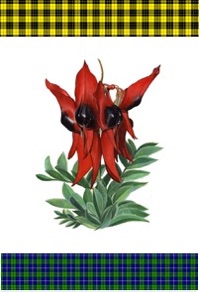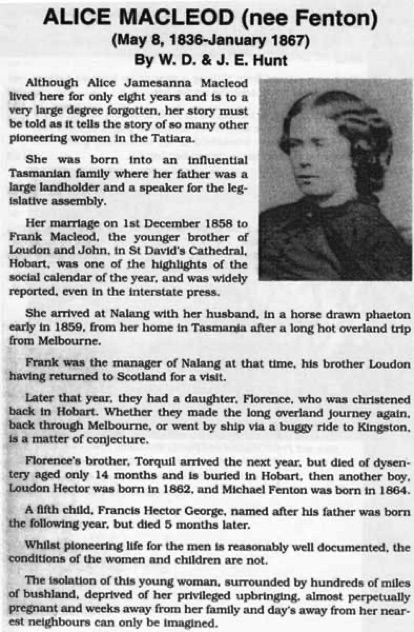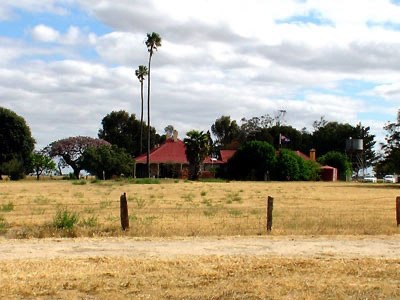
Clan MacLeod Society of Australia (South Australia) Inc.
_____________________________________________________________


Historical Connections with South Australia
Once Nalang was established, Loudoun seemed to follow his own fortune again and went to Scotland with his mistress (some sources quote her as his wife) Sophia Clarke and her daughter Charlotte Jane Crowe, and returned in 1861.
Francis was made manager at ‘Nalang’. He married Alice Fenton (22), of Tasmania in 1858, and returned to ‘Nalang’ where she bore five children in a short time. They were Florence, Torquil (died 14 months), Loudon Hector, Michael Fenton, and Francis Hector George (died 5 months).
In 1860, John 13th of Raasay died at ‘Nalang’ and was buried on the property.
A headstone reads:
'IN MEMORY OF – JOHN MACLEOD, Esq. – OF RAASAY AND – CHIEF OF THE CLAN – TORQUILE – WHO DIED JUNE 6 1860 – AGED 55 YEARS'.
In the ensuing years, ‘Nalang’ developed into a substantial productive property, on some of the best farming soil in the State. Almost the entire district comprised of just these three neighbouring properties all owned by fellow Scots. The industries of cereal cropping, wool farming, horses, cattle and lumber, created considerable employment and trade skills. Such was the volume and quality of the colonial wool trade, that in perfect irony, it undermined the Highland wool industry which had displaced Highlanders from their crofts in the first instance.
Frank’s wife, Alice, died in 1867 ‘of exhaustion’.
MacLeods of Raasay - 1838 to 1868
The British Colony of South Australia was proclaimed in 1836. The capital city of the free-settled colony, was named Adelaide, after Adelheide, consort of King William 1V. John Hindmarsh was the first Governor.
Colonel William Light designed the city as a grid pattern with wide boulevards, public squares and surrounded by parklands, against the River Torrens. Early Adelaide was shaped by religious freedom (called the City of Churches), and a commitment to political progressivism and civil liberties, which led to world first reforms. It had a planned migration and settlement under the Wakefield Plan, and developed the ‘Torrens Title’ land system.
While South Australia was opening up opportunities for migration and pastoral development, the Highlands of Scotland were in the midst of economic collapse and social upheaval. Tennant crofters couldn’t pay rents, over-population put demands on all resources, many Landlords, including Highland Clan Chiefs, found themselves in financial difficulties. Small communities, imbued with the customs and culture of the Highland Scots, were uprooted in the decades of programmes to relocate, reinvigorate and ‘improve’ the Highland natives. It became known as the ‘Highland Clearances’. Worse was to follow, as periods of ‘Potato Famine’, and other agricultural failures struck at the resilience of the people. In this developing gloom, James MacLeod 12th of Raasay died in 1823, having improved the estate on Raasay but leaving huge debts with his widow Flora, four surviving sons and daughter. The eldest, John, became 13th Chief of Raasay. The others were James, Hannah, Loudoun and Francis.
In 1838, James MacLeod was the first of the four MacLeod brothers to migrate to South Australia. James and his wife Mary (Mary Frances Theodosia, second daughter of Major General Sir Hugh Frazer KGB), arrived in South Australia on the ship ‘Pestonjee Bomangee’. They are not included on the passenger list, but arrived in the company of the colony’s second Governor, Lieutenant Colonel George Gawler and his wife, who had befriended Mary.
The original Government House in Adelaide was timber slab and mud construction (wattle & daub), with a thatched roof. Here, Mary MacLeod was invited to pitch a tent and teach piano and painting to the Gawlers’ children, while James MacLeod, accompanied by his Factor, William Douglas, also from Scotland, went to Sydney in the Colony of New South Wales, to obtain stock for their new property at McLaren Vale, 40km south of Adelaide.
James named the property ‘Rona’ after the small island at the north of the Isle of Raasay. James had brought farming equipment and pre-fabricated ‘Manning Huts’ from England.
James’s brother, Loudoun, and his mother Flora, had purchased the land from the South Australian Land Company and it is situated 4 km to the east of McLaren Vale. It was this land, sections 712, 713, which was named ‘Rona’, below ‘McLeod’s Hill’. (However, some other sections close to McLaren Vale have been found to have James’ name on the survey map. These are not yet fully investigated).
The youngest brother Francis (Frank) accompanied mother Flora, and sister Hannah to South Australia in 1840. The women resided in Tavistock Buildings, Adelaide, and Frank joined James on the property. James’ health was deteriorating since returning from Sydney, and it is presumed that Frank, and Loudoun, who joined them in 1841, along with William Douglas, managed much of the work.
James died on the property ‘Rona’ in 1844, age 31 years, and was buried under a large tree.
Flora, the mother of the four brothers, died in Adelaide in 1846 and according to her will, requested James’ body be interred with hers at the Adelaide Cemetery.
Mary, with their three children returned to England. Their son, named James Gawler MacLeod, entered military service and later died in Bengal in 1880, possibly not knowing that he had become 14th Chief of Raasay when his uncle John (the eldest brother), died in South Australia.
Meanwhile, the opportunities were opening for pastoral pioneers, and Loudoun moved east to Wellington on the Murray River, and from there further explored the Tatiara District with fellow Scots:- Binney and Scott.
One can imagine the heady atmosphere of ‘Gentlemen’s lounges’ where eager, land-grabbing pastoralists, opportunists, and hopeful migrants mixed with explorers enthralling them with incredible tales. Many of these men were Scots, and no doubt, characters like the great trans-continental explorer John McDouall Stuart, challenged and inspired fellow travellers.
Loudoun Hastings MacLeod took up a pastoral lease called ‘Nalang’, near Bordertown in the South East of the Colony, 180 miles from Adelaide, in 1845. It was here that Francis and John (13th of Raasay), joined him in managing this 126 sq.mile (90,000 acres) property, with a grazing capacity up to 28,000 sheep.
The expiration of the lease in 1868, and an inflated increase in new rates, conspired to force the MacLeods from the land. After this torrid period of business and family tragedy and grief, Francis vacated ‘Nalang’ (evicted) and took his three surviving children to Tasmania, where they were brought up by their maternal grandmother, Mrs. Fenton.
Loudoun MacLeod who had already moved to Adelaide, died that same year (1868) age 47.
The ‘Nalang Station’ passed through several ownerships until the Hunt family took possession in the early 1900’s. Bill and Jenny Hunt are current owners and proud and appreciated caretakers of this MacLeod history.
The succession of Chief of MacLeods of Raasay passed from John 13th to James Gawler 14th (brother to James’s son), then to Loudoun Hector 15th (Frank’s second son).

Alice and Frank MacLeod with family at Nalang c. 1866


Nalang
The family
John 13th of Raasay, had become Chief as a young man of 17 years upon the death of their father James 12th of Raasay. An officer in the 78th Highlanders, married Mary, daughter of Sir Donald MacLeod, and had a daughter, Mary Julia Hastings, who died aged 3, in 1839. On the Isle of Raasay, successive cereal crop failures, and cattle market fall, combined with costly estate renovations, led to his bankruptcy and the sale of Raasay estates to a southerner, George Rainey. The estates of Raasay had passed from the MacLeods after 500 years. John migrated to South Australia in 1844 and is buried at ’Nalang Station’. His headstone was restored and relocated into the house paddock in 2006.
James MacLeod
Died in 1844 and was buried under a gum tree at ‘Rona’. Flora’s will stated his body was to be exhumed and interred with her own at Adelaide. It led to this spectacular incident:
'A spring cart with 2 horses, an Undertaker, a digger, and a driver were sent from Adelaide to McLaren Vale to collect the coffin containing the remains of James. That task being done, the party departed ‘Rona‘. After a few miles they reached the summit of the hill overlooking the township of Noarlunga, in the horseshoe bend of the Onkaparinga River. The Undertaker, not one for taking risks, (but benefits from those who do), considered the hill too steep for the precious load. He chose to walk, while the driver, accustomed to such obstacles, proceeded down the hill. At some point the brakes of the cart failed, the horses startled and bolted, sending the cart careering downwards to the ford crossing at the base of the long slope. The driver and the coffin were thrown into the river, where the driver died of his injuries, along with the horses in the tangle of harness and cart.
A replacement cart was sent for and four days later James’ remains were again laid to rest, now at West Terrace cemetery, Adelaide, in a plot with his deceased mother.
The Horseshoe Inn, at the ford between two hills, once a rowdy pub for bullock drivers, smugglers and various intrepid travellers, burned down in the 1980’s. It must have been a scene of disquiet for 4 days in 1846 with such death and mayhem, and rumour. The Undertaker paid tribute to the driver for his devotion and assured the family and townsfolk that the remains of James were not scattered about the hillside and river.'
Loudoun Hastings MacLeod - other notes
At Nalang
'On the night of July 9, 1852, Loudoun MacLeod was aroused from his sleep by cries of distress from the wurley1 of his native servant Jenny (sic), who had served him faithfully for six years. He found that the occupants of the wurley had been assailed by ten Glenelg River Blacks2, who had murdered Jemmy and a 10-year old boy, and had endeavoured to carry off the former’s lubra3. There were ten spears in Jemmy’s body. MacLeod immediately dispatched a messenger to the Scott’s station, and got in touch with the Gold Escort4. Next morning MacLeod, John and Charles Scott, John Binnie, a Police Corporal and two native trackers set out after the offenders, and after 35 miles on horseback, came up with five of them on Henry Jones’s Binnum Run5. The blacks tauntingly challenged the whites to fight, and a spirited encounter with guns and spears ensued. One spear passed through MacLeod’s hat, another denuded the bark of a tree where the Scotts were posted. Later, three of the natives stood their trial in the Supreme Court, and were sentenced to death – Pot Pouch, alias Teapot, Ballycrack and Crackingyounger.'
Adelaide Stock & Station Journal 22 December 1926: Rodney Cockburn
Mrs. Mary Weirs wonderful memory
'Mrs Weir arrived at Port Adelaide when a child of seven with her parents , Mr. And Mrs. McLean, in 1853, on the ship ‘Neptune’. It was the time when the great rush to the Goldfields of Victoria was taking place, and labour was most unprocurable. The late Louden McLeod of Nalang Station was only one of many squatters6 who met the vessel in order to engage help in place of the men who had left for the Goldfields, and Mr. McLeod engaged Mrs. Weir’s parents and two other families – the McVicars and Bethunes - for sheep herd duty at Nalang they went straight to the Station on bullock drays7.'
Our Oldest Identity..The Border Chronicle 29/09/1933
Loudoun Hastings MacLeod died aged 47, in 1868, a ‘Gentleman of Pennington Terrace’.
Loudoun’s step-daughter, Charlotte Jane McLeod married Duncan McRae, (21-9-1869). She was born as Charlotte Jane Crowe, to James Crowe and Sophia Clarke, (10-02-1848). Sophia McLeod is buried at Bordertown (1881) (Chris Ward 2006)
Francis (Frank) Hector George MacLeod, the survivor of his family, went from Tasmania to Victoria to pursue interests, and little is known of his last years. He gradually lost contact with his children and died in December 1874. He is buried in the Melbourne General Cemetery, with his son by the same name, who died in February 1866, aged 5 months.
Alice Fenton died of 'exhaustion' on Jan. 26 1867 aged 30, at ‘Wirriga’, where Doctor Penny kept a hospital of sorts, neighbouring Nalang. Isolated by miles of bushland and deprived of the privileges of her upbringing, her struggle to raise a family and make a home, is at the heart of the character of pioneering women.
Her grave, adjacent to John’s, was unmarked until recently. Now a plaque has been cast to mark her life.
(Both the memorials have been moved to the ‘House paddock’ for protection from animal stock and machinery).
References
Morrison A. The MacLeods The Genealogy of a Clan, Section Four (Associated Clan MacLeod Societies, Edinburgh, 1990)
Other sources and acknowledgements
The MacLeods – The Genealogy of Clan, 2nd Edition:- A.Morrison, 1988
The Rich Valley (An account of the early life of McLaren Vale):- Adele Pridmore, 1949
The Observer, 20 June 1846.
Women of the Good Country; Vida Mancy Ed. Border Chronicle
Thanks also to Chief Roderick John MacLeod 18th of Raasay, and Chief Torquil Donald of the Lewes and their family for their input and co-operation.
Adelaide Cemeteries.
South Australian Department for Administration, Old Titles Section.
Footnotes
1 Camp shelter, tent, made of sticks, brush and bark.
2 Glenelg River area is over the border in Victoria, more than 100km distant. Blacks is a colloquial
term for Aboriginal person.
3 Native woman.
4 Nearby Bordertown Police Force for the transportation and protection of miner’s gold from the
Victorian Goldfields to South Australia.
5 Term for a sheep property of large size, eg 100sq. mile
6 A colloquial term describing the speculative occupiers of vast tracts of land pending lease
arrangements.
7 Gelded bulls, in teams of 4-8, hauled wagons or flat top ‘Jinkers’ of wool, logs etc. as heavy transport.
This distance of 300 km was an uncomfortable three – four week journey, walking most of the way.


© 2008 - 2018 Historical Connections with South Australia -MacLeods of Raasay - 1838 to 1868